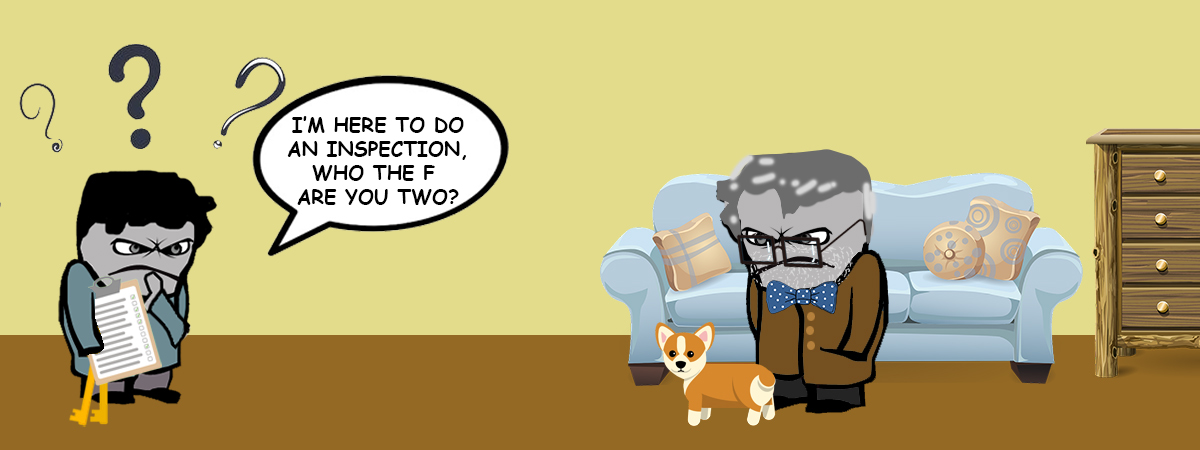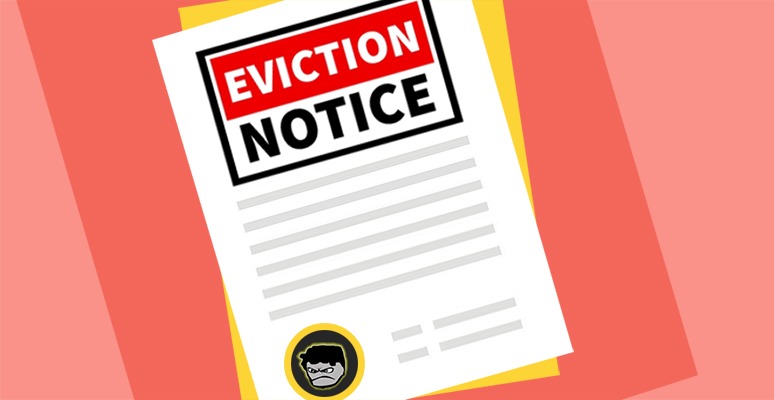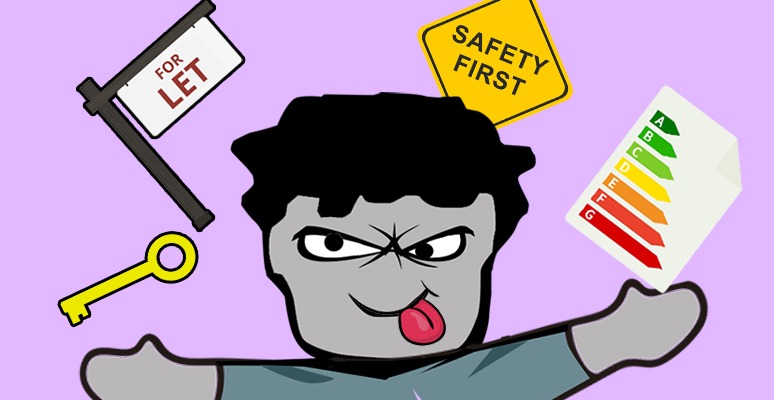
Sub-letting is one of those circumstances that can swing either way, it can be a beautiful thing or a complete pain in the ass.
If you’re a landlord, you’re probably reading this for one of two reasons:
- 1) You’ve recently discovered your tenant is sub-letting and you want to know the legal implications i.e. what your rights are.
- 2) You’ve had problems with a sub-tenant, and now you want to know how to get rid of the bugger.
In reality, most landlords don’t even know their tenant is sub-letting. Worrying! But that’s presumably not a problem (and it’s not in most cases), because if you’re unaware, it means the tenant is paying rent on time and everything is running smoothly. In other words, [sometimes] ignorance is bliss.
Personally, if I discovered my tenant was sub-letting without my consent, yet rent was paid on time every month and the property was being taken care as discovered through regular property inspections, I wouldn’t rock the boat. I mean, what’s the point? Sure, I’d probably be a little annoyed because my toe-rag tenant didn’t have the courtesy to ask for my permission, but beyond that… meh. I want an easy life.
In any case, let’s run through the FAQ’s…
Page contents
- What is subletting?
- Most important aspects of subletting
- Subletting with the landlord’s permission
- Why do some tenants sub-let?
- What should you do if your tenant asks permission to sublet?
- How to prevent subletting
- My tenant has sublet without my permission
- Eviction sub-let tenant
- I’m sub-let friendly, but who is responsible for the sub-tenant?
- The sub-tenant is a lodger
What is subletting?
Just so we all start from the same page…
When a tenant makes an agreement to accept rent from a person who is not part of the original tenancy agreement we call that sub-letting.
The sub-tenant/sub-letter (is that a word? Sounds more like a short note) has no legal relationship with the landlord, but is contributing to the rent.
Only the “official tenant” (let’s call him the OT) has the rights of a tenant, and the landlord only has legal obligations to the OT.
The OT is pretty much in the same position whether he has agreed with the landlord that he will be sub-letting or is sub-letting without that agreement (but it’s usually without the owners’ knowledge). The sub-tenant, to keep it simple, is the OT’s lodger, and has the rights of a Lodger, therefore the sub-tenant is NOT technically a tenant, so does NOT have tenant’s rights.
Most important aspects of sub-letting
Whether you’re willingly or unwillingly have a sub-tenant in your property, you need to ensure the following…
- Many mortgage lenders do NOT allow sub-letting, so ensure it’s permitted otherwise your policy could be void and your lender may have the right to withdraw the loan. Yes, worrying.
- Many BTL Insurance policies do NOT allow sub-letting, so ensure it’s permitted otherwise your policy could be void and you may not be entitled to make any claims if the time comes. Again, worrying!
If it’s not permitted, the Insurer may increase the premium in order to include it in your policy. Of course, your Insurer may not allow it altogether, so you will need to find a new insurer that does cover sub-letting.
Subletting with the landlord’s permission
Subletting is perfectly normal, many landlords allow it.
In fact, some tenants make a business out of sub-letting, and it can be both profitable for the tenant and landlord.
There is a business known as ‘Rent to Rent’ where people, who often have no money of their own to invest in property, agree to pay a property owner a guaranteed rent for a specified period with the sole purpose of renting that property to tenants who will pay them more than they are paying to the owner.
This can be a mutually profitable relationship but there are pitfalls:
- The word “guarantee” doesn’t actually mean, it’s reliable as a wet paper-bag. If the OT has no money to invest in his own property to rent, then it’s probably fair to assume you won’t get paid until he gets paid.
- If the contract says that the OT will be responsible for repairs and replacements, then the landlord needs to keep an eye on the property to ensure that they are carried out. He is the person named at Land Registry and he will be the person that the council will go after if there are Health and Safety issues.
- A Rent to Rent contract cannot be an AST unless the OT intends to live there with the sub-tenant. If he doesn’t, he will not actually be a tenant. It is also not a Company Let Contract because the occupiers will not be employees of the company. The Contract needs to be a Commercial Lease Agreement.
- There are some large companies who operate very successful Rent to Rent businesses and they will have insurance in place or funds to support their guarantee. Many councils offer landlords Rent to Rent contracts and use the properties to help them to house people on their waiting lists or as emergency accommodation.
Why do some tenants sub-let?
Sometimes it’s a simple case of economics- the tenant wants to stay in the property but cannot afford the rent and/or the running costs. Sometimes their financial circumstances change during the tenancy, consequently they take in a sharer to help with the bills.
Some people just feel lonely or insecure living alone, particularly in unsavoury areas, so they want someone else in the property.
What should you do if your tenant asks permission to sublet?
If your tenant comes grovelling and asks for permission to sub-let, then you need to decide how that will work for you. You are not Social Services and you haven’t got to agree, but if you’ve got a good tenant, you might want to keep him.
Also think about what you will do if the OT decides to move out and you have no contract with the sub-tenant who wants to stay. You will be totally reliant on the OT sending the sub-tenant packing before he vacates, or you may have a very messy eviction case on your hands.
Assuming that doesn’t happen, but they both decide to vacate because you’re being a meanie-poop by not allowing sub-letting, you will then be in a position where you will need to spend time and money on finding new tenants, and that could be expensive, particularly if there is a void period during the process.
How can landlords prevent sub-letting?
If you’re adamant against subletting – many landlords are, ain’t nothing to be ashamed of – the following will help prevent it from happening altogether, or discovering the arrangement sooner rather than later…
- Carry out regular property inspections. Here’s a guide on landlord property inspections. Showing your tenant you do regular inspections could act as a deterrent- it will make them think twice.
- Make friends with the neighbours – there’s always a curtain twitcher who will grass ’em up. Take the time to talk them between lets and during inspections, and make sure they have your contact number.
- Put a clause in your tenancy agreement which forbids sub-letting – if they ignore it, you may have grounds to serve Section 8 eviction notice. If there is no clause to prohibit sub-letting the tenant might see that as a green light. A clause might read something like:
5.5 Assignment and Subletting
5.5.1 The Tenant agrees not to assign sublet, part with or share the Premises with any persons other than the persons named as the Tenant or any other person approved of in writing by the Landlord to occupy or reside in the Premises.5.5.2 Not to take in Lodgers or Paying Guests without the Landlord’s written consent.
- Never charge extra fees nor deposit which would amount to more than 1/6th of the annual rent because these payments are called a Premium and that gives your tenant the right to assign the tenancy to another person without your permission.
- Develop a good relationship with your tenants so that they can talk to you if they are struggling with rent or bills, this will give you a fighting chance of being told if they are considering sub-letting.
- Do thorough tenant referencing.
My tenant has sub-let without my permission, what can I do?
Unauthorised subletting is where it can go all terribly wrong, and increasingly is. It typically works in two different ways:
- Scenario 1: your tenant is renting out another room/space in your property without your permission
- Scenario 2: this is generally the more concerning scenario, when your tenant doesn’t even live in the property and has sub-let the entire house.
Scenario 1:
Upon discovering that your property is being sub-let without your permission, first decide if it’s causing a problem. As said at the beginning of the post, it might not be worth rocking the boat if there are no negative consequences of your tenant sub-letting (e.g. rent is being paid and the property is being kept in good condition). IF that’s the case, talk to your tenant about the situation.
Scenario 2:
In many cases, it’s not such a fairy-tale ending. Many unscrupulous people make a living out of unauthorised sub-letting, and this is when the reality of the situation can be extremely scary.
This is when the OT draws up tenancy agreements for individual rooms and let the rooms out separately to strangers, acting as if they are the real landlord. This can lead to a number of problems. First, the new tenants aren’t aware of who the real landlord is. If there is a problem with the property, illegal sub-letters are unlikely to attend to them, and if they do, the problems aren’t usually resolved to a good standard. Secondly, most unauthorised sub-letting leads to overcrowding- this is because the sub-letter tries to cram in as many tenants as possible to maximize profit. Needless to say, an overcrowded property often leads to damage.
Regardless of whether your situation falls into scenario 1 or 2, you may want the sub-tenant to vacate, in which case you can do the following…
- Talk to the OT directly to try and resolve the situation- or at least make him aware that the jig is up. The OT may just admit defeat and close up shop;
- if that fails, the sub-tenants should be spoken to directly to clarify the situation as they may well be unaware of the circumstances themselves. They could be understanding and willingly vacate. However, if you and the sub-tenants are happy for them to remain in the property, cut out the middle man by going through the proper procedures to have the tenancy negated, then draw up a new tenancy for each resident. But under no circumstances should you accept any payment of rent until the matter is sorted.
- If you’re still adamant on removing the tenant/sub-tenants, enforce the term in your tenancy agreement if there is one, and warn the OT to remove the sub-tenant(s) or you will serve Notice to evict him because he is in breach of contract;
- If there is no clause, you could say you’re insurer/lender does NOT permit subletting, so the sub-tenant must leave;
- If that doesn’t work, you could try serving a Section 8 on Ground 12 to your tenant.
Note: never accept payment direct from a sub-tenant as this would be a form of consenting to a new tenancy agreement with them.
How do I evict/repossess a sub-let tenant (even if I’ve never met him, but gave my tenant permission to find the sub-let tenant)?
You don’t, you can’t, only your OT can remove him, but you can remove your OT by going through the Section 21 Possession Process, and when you have legal possession, enforced by a Court Appointed Bailiff, they will remove all occupiers and give you back a vacant property in line with your Court Order.
I’m sub-let friendly, but who’s responsible for the sub-tenant?
The OT is responsible for anything that happens in the property during his tenancy, and that includes anything which he has allowed a sub-tenant to do.
A sub-tenant has no legal relationship with the landlord. However, take care not to create one by accepting rent/deposit from the sub-tenant. If there is any damage the monies can be stopped from the deposit of the OT.
The sub-tenant is a lodger
Remember, if your tenant has a sub-tenant, they are technically your tenant’s lodger, not your tenant- not your anything. They are only your tenant’s lodger. You with me? Wonderful.
That means your tenant’s lodger has ‘lodgers rights’, and is covered by lodger statutory rights. For more information on lodgers, particularly what their rights are, or how to remove them, you may want to visit the excellent lodger site.
Please note, you should always get independent legal advice before taking any action. The content on this website is just for information purposes and is only based on my opinions/experiences. For more information on subletting/lodging, you may want to go over to the Citizen’s advice website.
So, why did you land here? What’s your story? Do you have a good or bad sub-letting experience? Please leave a comment and share it with the world…
Disclaimer: I'm just a landlord blogger; I'm 100% not qualified to give legal or financial advice. I'm a doofus. Any information I share is my unqualified opinion, and should never be construed as professional legal or financial advice. You should definitely get advice from a qualified professional for any legal or financial matters. For more information, please read my full disclaimer.


 Landlord Products / Services
Landlord Products / Services

























My tenant has CLAIMED in court that my managing agent had given him VERBAL consent to sub-let.
NOTE the AST agreement clause prohibits SUBLETTING WITHOUT CONSENT.
If there is no specific reference to 'consent in writing'is the tenant defence strong?